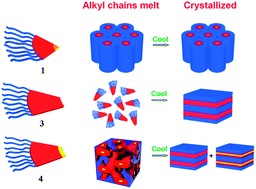The gyroid structure with its interesting and mysterious symmetry has attracted the great attention of scientists with a variety of backgrounds. Constituting the gyroid structure through a precise control of the (macro)molecular architecture and the properties of its building blocks is a challenge. In this work we report our effort in creating a gyroid nanostructure in a Janus amphiphilic codendrimer consisting of two third-generation dendrons, a hydroxyl-terminated poly(methallyl dichloride) dendron and a poly(urethane amide) dendron terminating in long alkyl chains. Through the manipulation of the shape and amphiphilicity of the dendrons and codendrimers and the identification of the corresponding supramolecular structures, we find a correlation between the resulting nanostructures and the unique molecular shapes, the distribution of polar and functional groups, and the crystallization or melting of the long alkyl chains. The findings can direct us to new pathways of constructing supramolecular nanostructures, particularly non-trivial structures such as the gyroid, through precisely manipulating and controlling molecular shape, polarity and functionalization, not only for block codendrimers.

You have access to this article
 Please wait while we load your content...
Something went wrong. Try again?
Please wait while we load your content...
Something went wrong. Try again?


 Please wait while we load your content...
Please wait while we load your content...